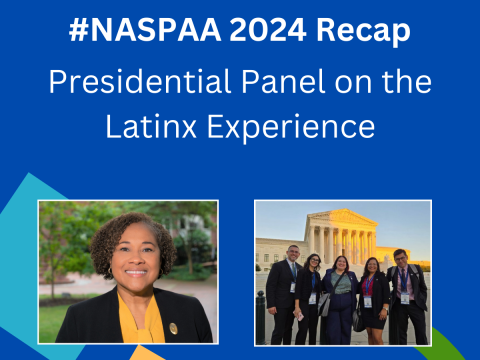NASPAA 2024 Recap- Presidential Panel on the Latinx Experience

One of the many exciting events at the 2024 NASPAA Annual Conference in Washington, D.C. this past October was the Presidential Panel series led by 2023-2024 NASPAA President, Dr. RaJade M. Berry-James.
In this recap, you will find a summary of the Presidential Panel titled “Leading Forward: The Latinx Experience in a Public Administration PhD Program” in which doctoral students from the University of Nebraska at Omaha (UNO) shared their experiences as Latino students in the field.
Special thanks to the panelists and authors of this blog: Paola Briones, Yuriko Doku, Monica Lea, Ignacio Ruelas Avila, and Roger Garcia.
RECAP
With 36.2 million eligible voters, the Latinx population is the second-fastest-growing voting block (Krogstad, 2024). If all the Latinx communities living in the US were an independent nation, they “would be the fifth-largest economy in the world” (Hamilton et al., 2024, p. 5). Yet only 9% of public administration and social services doctorates were granted to “Hispanic” or Latinx people in 2020-2021 (U.S. Department of Education, 2022).
To center equity, the establishment of fair and just systems and practices that recognize individual differences and sociopolitical contexts (NASPAA, 2020), Latinx students must engage in dialogue, collaboration, and shared leadership regarding the future. Current Latinx doctoral students convened via Leading Forward: The Latinx Experience in a Public Administration PhD Program, providing two takeaways.
Doctoral Faculty Can Mitigate Challenges
Personal obligations, including raising families and balancing full-time employment with a doctoral program, pose challenges for many Latinx students. Hybrid or remote courses may facilitate Latinx students’ involvement in their doctoral program. Students can be surveyed to gauge in-person class times that work holistically with their priorities.
Latinx students are often the first in their families to attend college and pursue advanced degrees. Navigating academia can contribute to the imposter syndrome, insecurities regarding language or writing abilities, and ignorance of doctoral program opportunities. Faculty mentorship can bolster students’ confidence. Mentorship can also facilitate networking, research, and professional development, including co-authorship and collaborative publishing. Doctoral student Paola Briones stated, “I depend on my advisor to tell me what I don’t know—there are few people I know that have gone through this experience as a Latinx person.”
Application fees, tuition, and conference registrations pose financial barriers for Latinx students entering the field of public administration. This hinders the incorporation of Latinx students in public administration academe and practice. Diversity initiatives and equity-minded funding can support Latinx students in their programs and beyond.
Collaboration with the Latinx Community
As the Latinx population continues to grow, the field of public administration must be responsive to the needs of this diverse citizenry. Culturally responsive leadership should approach our community with cultural humility, facilitating Latinx active representation rather than passivity or tokenism. Doctoral student Roger Garcia emphasized the importance of teaching our future generation of researchers and practitioners how to effectively and respectfully overcome barriers in language, culture, and trust when attempting to work with ethnically diverse communities. Doctoral Candidate Yuriko Doku noted that employing "popular education" methods in disseminating research can help the Latinx community better understand relevant study findings, enabling them to utilize or implement these insights effectively.
Intentional feedback from Latinx constituencies requires close, constant dialogue with the community and elevating the Latinx narrative when barriers to access exist or systems fail to adequately serve the community. Doctoral Candidate Monica Lea expressed, “I’m a no sabo kid. So not being able to speak Spanish is not an excuse for not engaging with the Latinx community. There are ways to bridge that gap if it exists.” Research centers at US universities should utilize Latinx Spanish speakers to create impactful research aimed at enhancing these communities, as highlighted by Doctoral Candidate Ignacio Ruelas based on his experiences at UNO.
Latinx students represent intersectional identities and varied experiences. Faculty and staff must recognize this to support Latinx students as individuals, harnessing our unique experiences to enrich research, service, and teaching. We would like to thank NASPAA President Dr. Berry-James for facilitating our panel, and the NASPAA Diversity and Social Equity Committee for endorsing us. The University of Nebraska at Omaha’s College of Public Affairs, and Community Service; School of Public Administration; and the Mary and Rodrigo Lopez Fellowship for Professional Development were also invaluable allies. We look forward to continuing this important conversation and collaborating with NASPAA again soon.
References
Hamilton, D., Fienup, M., Hayes-Bautista D., Hsu, P. (2024). 2024 U.S. Latino GDP Report. https://latinogdp.us/
Krogstad, J. M. (2024). Key facts about Hispanic eligible voters in 2024. Pew Research Center. https://www.pewresearch.org/short-reads/2024/01/10/key-facts-about-hispanic-eligible-voters-in-2024/
NASPAA. (2020). NASPAA Diversity, Equity, and Inclusion-Related Definitions. DEI Definitions. https://www.naspaa.org/sites/default/files/docs/2020-12/DEI%20Definitions-Final12-17-20.pdf
U.S. Department of Education. (2022). Digest of Education Statistics. National Center for Education Statistics. https://nces.ed.gov/programs/digest/d23/tables/dt23_324.25.asp

